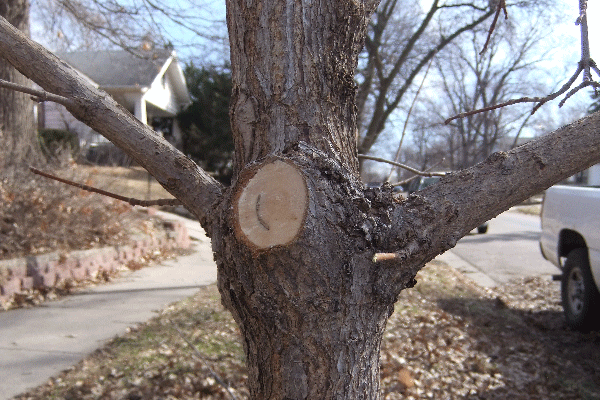Beyond properly selecting and planting trees, one of the best ways we can care for them is to “structurally prune” trees, especially young trees. Proper pruning at the right time can help them withstand wind, snow and other weather extremes.
Most trees are native to a forested environment where there is intense competition for light, which tends to force trees to grow “up” and maintain a single dominant stem and strong structural branches. Removed from that environment and planted in full sun—in home landscapes and in streets, parks and other planted landscapes—they tend to grow out rather than up. The canopy exposure to full sunlight causes them to develop a much broader and fuller crown, typically with multiple competing stems and weakly attached branches. Over time the natural form of that tree species is lost and they’re much more susceptible to damage from storm events.
A majority of these problems can be prevented by structural pruning when the trees are young. Structural pruning is the purposeful removal of weak branches and correction of poor branching structure. Pruning while trees are small also helps minimize tree wounding and results in stronger mature growth.
Most structural pruning can begin after the tree has become established in the landscape, typically 3-5 years after planting. Late winter, before spring growth starts, is one of the best times to prune because it’s easier to see the entire crown and branch attachments without the leaves obscuring your view. It also means fresh wounds are only exposed briefly before new growth begins. Another plus with spring-blooming trees is that you can bring the cut branches indoors to see if they’ll bloom.
Structurally pruning young trees involves:
- Identifying the lowest permanent scaffold branches to remain on the tree.
- Cleaning the crown by removing dead, broken and dying branches.
- Choosing and developing one dominant leader. It may take several years of pruning to either remove competing co-dominant stems, or slow down their growth by pruning them back..
- Selecting permanent branches approximately every 16” along the stem of the tree. It’s best if these permanent branches are spaced out in a radial pattern around the stem and to favor, and leave in place, branches with strong attachments and visible branch bark ridges.
- Removing only about a fourth of the crown at a time, which means it may require several years of gradual pruning to correct branching problems.
It is both an art and a science to do structural pruning correctly but the end goal is trees that are strong enough to tolerate extreme weather. Visuals and videos can help with details like where and how to cut, the angle of the cut, maintaining the bark ridge at the bottom of the branch and other best practices. One good guide to structural pruning can be found on the International Society of Arboriculture (ISA) “Trees are Good” web page.
The Nebraska Forest Service strives to enrich lives by protecting, restoring and utilizing Nebraska's tree and forest resources.

